
|
xTuple ERP Reference Guide |
To create a new Quote Line Item, select the NEW button. The following screen will appear:
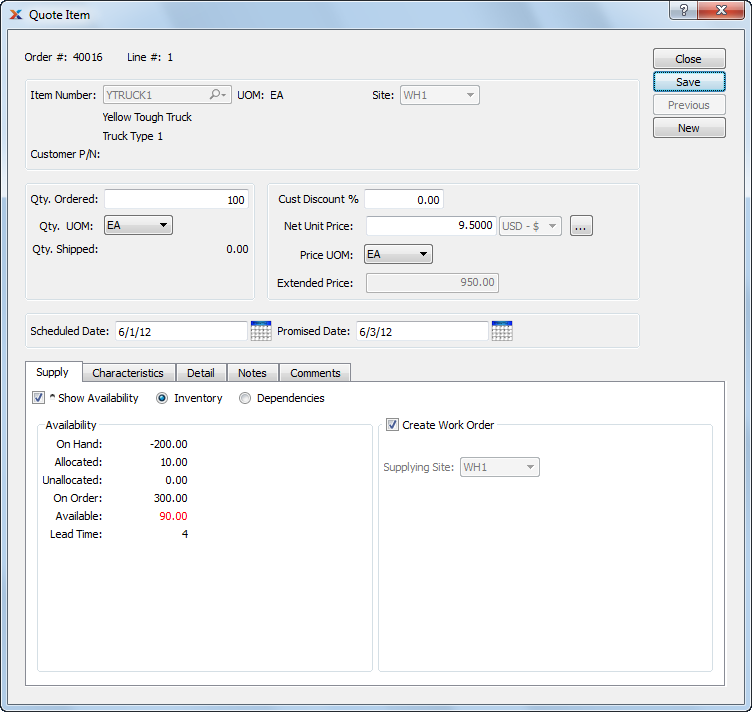
When creating a new Quote Line Item, you are presented with the following options:
Displays the Order Number specified in the header screen.
Displays the Line Item Number for the current Line Item.
Enter the Item Number of the Item you want to sell. The Item list will contain sold Items available for purchase by the specified Customer. The list of available Items may vary from Customer to Customer, depending on how Pricing Schedules are implemented at your site. Once an Item Number is entered, the Inventory Unit of Measure and Item description will automatically appear.
Displays the Customer Part Number (i.e., Item Alias) that corresponds to the Item Number entered in the Item Number field. If the Alias is associated with a particular Customer account, then the Alias will only be displayed for Sales Orders and Quotes entered for that Customer. Item Aliases are defined on the Item master.
Optional selection used solely for gathering information related to Sales Order Line Item substitutions. This feature can be used, for example, to gather information about Inventory shortages or Customer first preferences. There is no impact on the system of using this feature. Its function is simply to store information in the database, where it may be accessed for reporting purposes.
Specify the Site the Sales Order Item is sold from. Items may be supplied to Sales Orders from multiple Item Sites. After an Item Number is entered above, the system checks for available Item Sites for the Item. Any Item Sites having the "Sold from" flag set on them will be selectable from this Site list. By default, the Item Site having the highest Ranking will be selected as the first available Site. If more than one Item Site share a Ranking of "1," the Sites will be sorted in alphabetical order. Item Site Rankings are set on the Item Site master.
If a preferred Selling Site is specified for the Customer, then that Site will be selected here by default. If the preferred Selling Site is not selected—and you think it should be—verify that the Item Site master for the Line Item in question is marked as a "Sold from" Site.
Enter the quantity of the specified Item being ordered.
The quantity ordered is based on the Quantity Unit of Measure.
Specify the Unit of Measure to be used when selling the Line Item. Sold Items may be assigned multiple Selling UOMs. These alternate UOMs may be defined on the Item master. If a Line Item has no Selling UOM defined, then the Inventory UOM will be used here by default.
Displays the Line Item quantity shipped (if any) to date.
Specify here and apply any discount for specified Customer for this Quote. This is a discount off the regular Customer Price, obtained either from the Customer master or a Pricing Schedule.
Displays the Unit Price for the Quote Item. By default, the system will choose the lower of the following two Prices: A) The most-specific Pricing Schedule Assignment or B) any Sale in effect at the time of Order entry. The specificity of Pricing Schedule Assignments is determined in the following descending order: By Customer Ship-To Address (most specific), by Customer, by Customer Type, by Customer Type pattern, by all Customers. The lookup feature located to the right of the field leads to a Price List screen.
If your Pricing Schedule has multiple Units of Measure (UOM) on it (or if several Pricing Schedules share the same level of Price specificity, but they have different UOMs) then the UOM which matches the selected UOM will be chosen—that is, as long as the quantity break does not exceed the quantity being priced. If no entry matches the UOM with a quantity break less than the quantity being priced, then the lowest value Price for any UOM will be chosen. To make sure a specific UOM is always chosen at the desired level of Price specificity, then your Pricing Schedules should include at least one UOM with a quantity break of 0.
The system can be configured to prevent users from editing the Net Unit Price. If your system is configured that way, the Net Unit Price field will not be editable. The Unit Cost and Unit Cost Markup % values on the Details tab can also be configured to be editable with permission settings. These values, if changed, will adjust the Net Unit Price.
The Price Unit of Measure is the same as the Selling UOM. If an Item has Selling UOMs defined, then the Item may be sold and priced in these alternate UOMs. If no Selling UOMs are defined, then the Inventory UOM will be used here by default.
Displays the Extended Price. The Extended Price for a Line Item is based on the quantity ordered multiplied by the Net Unit Price.
The scheduled date is the date when the Line Item should be Shipped. The user who enters the Line Item is responsible for determining the scheduled date. After entering the scheduled date, hit the TAB key on your keyboard to display values in the remaining display only fields.
The Sales Order Item having the earliest scheduled date will determine the ship date for the Sales Order.
Enter the date when you promised delivery of the Line Item. This is an optional field. It will only be displayed on the screen if your system is configured to enable promise dates.
When entering Quotes you have the ability to view current availability for Line Items. You may also create replenishment Orders if they are needed.
Select to display Availability information for the Quote Item in the following categories:
Select option to view Inventory availability.
Displays the current Quantity on Hand value.
Displays the quantity allocated to current Sales Orders and/or Work Orders in the system. An Item is considered allocated to a Sales Order if a Sales Order Line Item exists for the Item—and that Line Item has not yet been issued to Shipping. An Item is considered allocated to a Work Order if the Item is a material requirement—and the material has not yet been issued to the Work Order. Once the current Sales Order Line Item is saved, the "Allocated" value will increase by the quantity ordered.
Displays the Quantity on Hand remaining after allocations have been accounted for, as in: QOH - Allocated Qty. = Unallocated Qty.
If the Quote Item is a manufactured Item, the quantity ordered by current Work Orders will be displayed. If the Sales Order Item is a purchased Item, the quantity ordered by current Purchase Orders will be displayed.
Displays the available quantity. Available quantity is determined using the following formula: Unallocated Qty. + On Order Qty. = Available Qty.
Displays the Item Site Lead Time for the specified Line Item.
The "Show Availability" feature can be turned on or off by default at the system level. If the feature is turned on, the Availability totals will display only after a Scheduled Date has been entered for the Line Item.
If the Line Item is a manufactured Item, select this option to automatically create a Work Order for the specified quantity. For make-to-order manufactured Items, this option will be selected automatically. A Work Order will be created to meet the Sales Order demand once you save the Line Item to the Order. An Item is designated as make-to-order if the "Stocked at" flag on the Item Site master is not selected. A Work Order created automatically from a Sales Order Line Item will assume the same Order Number as the Sales Order the Line Item is associated with—even if that Order Number has already been used by a previous Work Order.
For purchased Items, two different options may appear, depending on how the Item Site for the Item is set up:
Create Purchase Request
Create Purchase Order
In either case, you will be given the option to override any Item Source Price(s) which are in place. Also, linked Purchase Orders will be updated when Sales Order details are changed. If your site is configured to use drop shipping, an additional "Drop Ship" flag will also be shown for linked Purchase Orders. The drop ship function will search for an existing Purchase Order linked to the Sales Order with a matching Ship-To Address and add the Line Item to that Order—or create a new Order if none exists. Drop ship Purchase Orders inherit the Ship-To Address and Contact information from the Sales Order. Item Sources must be defined for drop ship Items—including each component of a Kit Item.
Specify the Site a corresponding Work Order would be supplied from. Work Orders may only be created for manufactured Items having a supplying Site. Sites designated as "Supplied at" Sites in the Item Site master for an Item are considered supplying Sites. If no supplying Site exists for an Item, a Work Order may not be created for the Item.
Select option to review any components dependent on manufactured line Item.
Displays components Items associated with sold manufactured Item in a nested list with a plus ("+") sign located to the far left of the screen next to each line that may be expanded to lower levels. By clicking your mouse on a plus sign, you reveal lower levels of information related to the Line Item.
The following buttons are unique to this screen:
Select to view previous Line Items associated with the Quote.
Select to create a new Quote Line Item.
If an Item has Characteristics associated with it, you have the option of linking those Characteristics to a Sales Order Line Item. And, in the case where Sales Order demand automatically generates either a Purchase Request or a Work Order, the Characteristics defined here will be inherited by those subsequent Orders.
You can link Characteristics and Values to an Item by using the Item master. Once entered, these Characteristics and Values will be available to users entering Sales Order Line Items.
To associate Characteristics with a Quote Line Item, select the "Item Characteristics" tab at the bottom of the screen, as shown below:
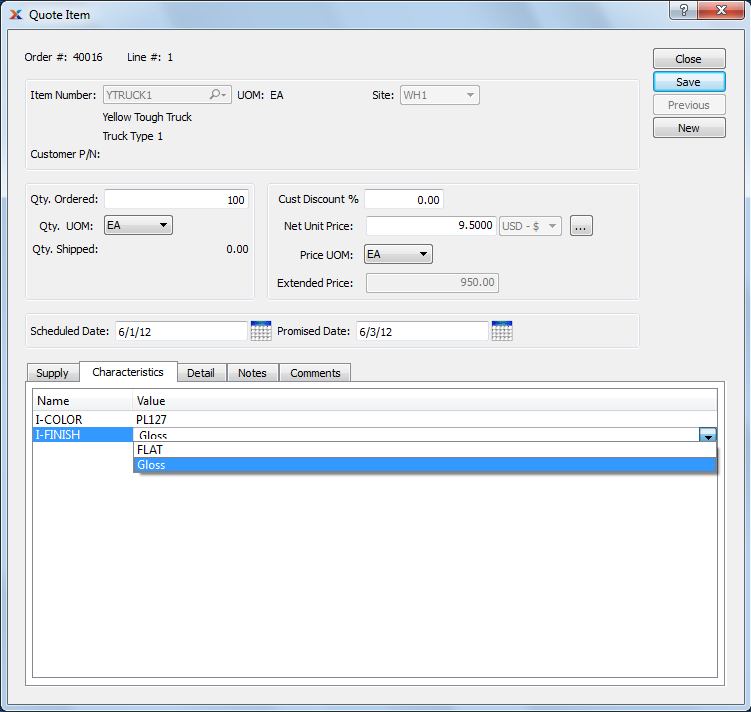
When selecting or editing Characteristics for a Quote Line Item, you are presented with the following options:
Displays the name of any Item Characteristics associated with the Item. Characteristics defined as Item Characteristics may be associated with Items on the Item master.
Displays the default Value associated with an Item Characteristic, but permits you to specify an alternate Value. When associating Characteristic Values with a Quote Line Item, you have four options: 1) Select the default Value; 2) select an alternate pre-defined Value; 3) manually enter a new Value in place of the pre-defined Value; or 4) make no selection. Making no selection means the Characteristics will not be associated with the Quote Line Item.
If the Quote Item is a configured Item (i.e., Job or Reference Item), the "Base Price" option will be shown. Characteristics associated with configured Items may have additional List Prices associated with them. As a result, when Characteristics are added to a Quote Item, the overall Price of the Item may increase. The Base Price shows the Price before any Characteristic List Prices have been added to the Net Unit Price. To learn more about adding price Characteristics to configured Items, see Section 2.1, “Enter New Item”.
To view Costs or adjust Tax information for a Quote Line Item, select the "Detail" tab at the bottom of the screen, as shown below:
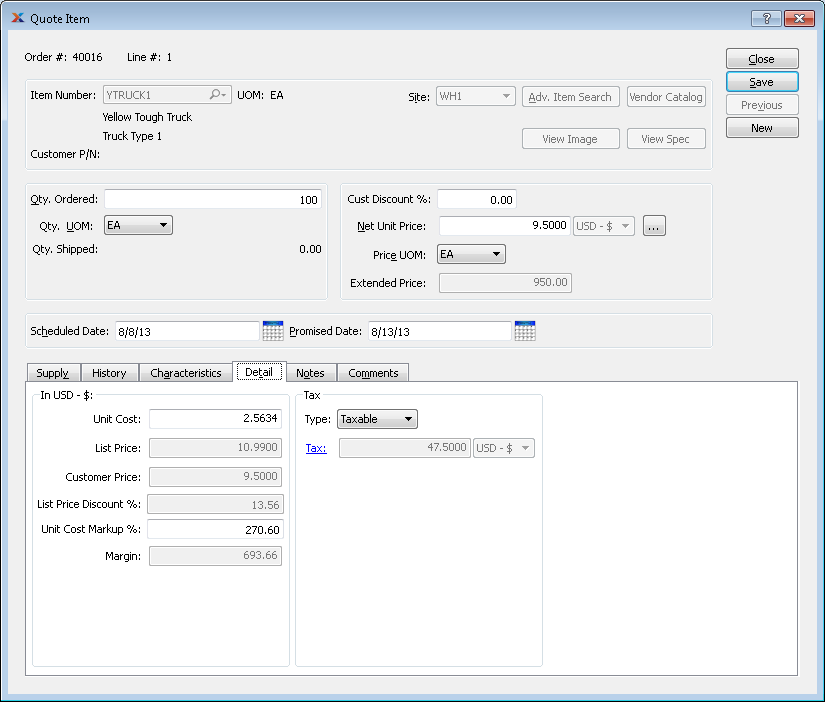
When viewing Costs or adjusting Tax information for a Quote Line Item, you are presented with the following options:
Depending on configuration settings, the Unit Cost displays the Wholesale Price, or the standard or average Inventory Cost.
This value can be changed if the user has the necessary permissions. A change in this value will result in a new Net Unit Price.
Displays the sales List Price per unit.
Displays the Price given to the specified Customer. Special Customer Prices can be set for individual Customers or Customer Groups by using a Pricing Schedule.
Displays the percentage discount off the List Price. Indicates the difference between the List Price for an Item and the Net Unit Price as a percentage. This is the margin between the Net Unit Price and the List Price.
Displays the effective markup which is based on the Unit Cost and Net Unit Price values.
Like the Unit Cost, this value can be changed by a user with sufficient permissions and such a change will adjust Net Unit Price.
Displays the difference between extended price and extended cost.
The following Tax options are available, should you need to override the Tax Selection settings for the Line Item:
Specify the Tax Type for the Sales Order Item.
Displays the amount of Tax to be charged for the Sales Order Line Item quantity. To get a detailed view of the Tax calculation, click on the Tax link using your mouse.
To enter Notes related to a Quote Line Item, select the "Notes" tab at the bottom of the screen, as shown below:
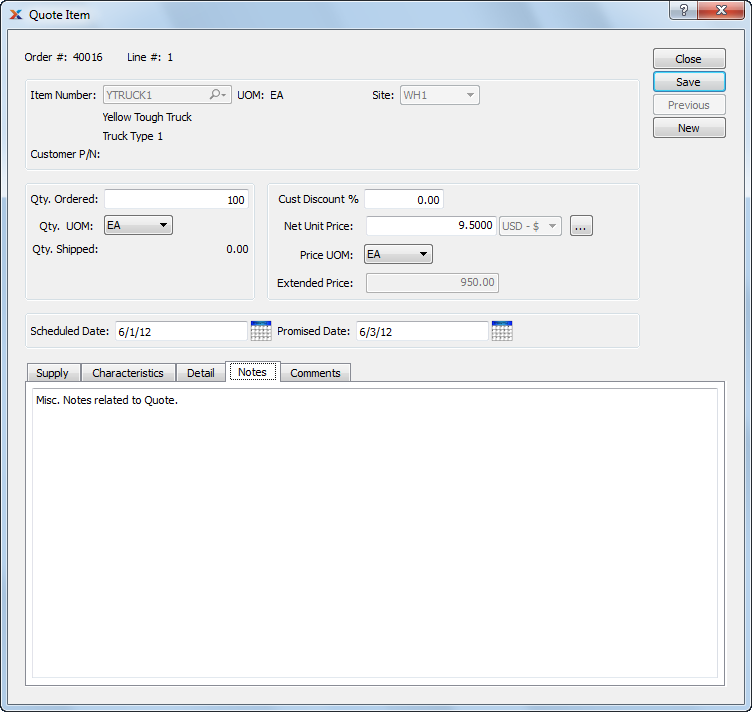
When adding Notes related to a Quote Line Item, you are presented with the following options:
This is a scrolling text field with word-wrapping for entering general Notes related to the Quote Line Item.
If a Quote Item is marked to create a Work Order, the Production Notes for the created Work Order will contain the Quote Number, the Customer Name, and any additional Quote Line Item Notes.
To add Comments related to a Quote Line Item, select the "Comments" tab. The following screen will appear:
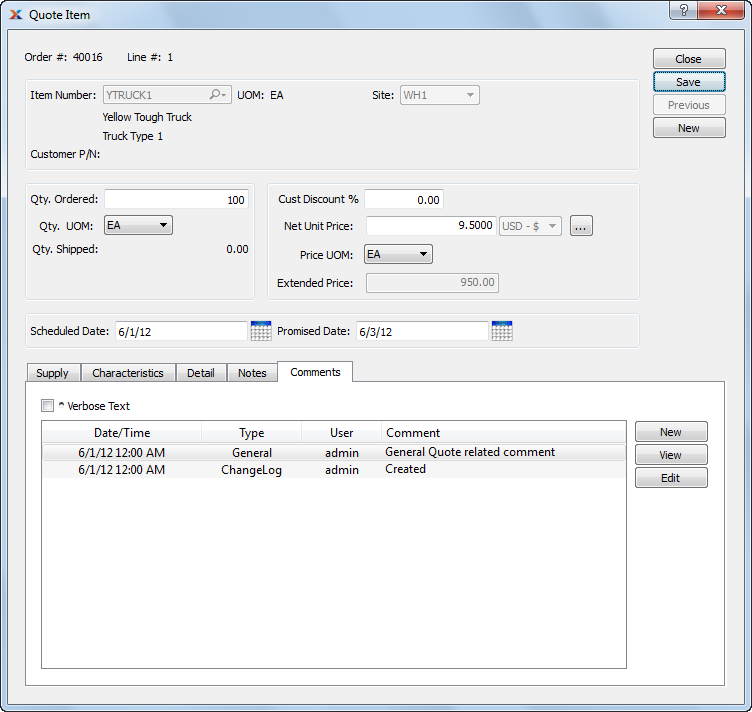
Whenever Quote Line Items are created or their quantities are changed, the system will automatically generate a Comment, which will appear in the list of Line Item Comments.
When adding or reviewing Comments, you are presented with the following options:
Select to display all Comments in the list in an expanded view which includes the entire text of each Comment. To edit a Comment, simply select the "Edit" link next to the Comment. That link will not be shown for Changelog Comments, which can't be edited. If the "Verbose Text" option is not selected, the Comment list will display only header level information for each Comment.
Display lists Comments related to the record.
The following buttons are available:
Opens screen for creating a new Comment.
Highlight a Comment and then select this button to reach a read-only view of the "Edit" screen.
Enables you to edit highlighted Comments—as long as the Comments are not "ChangeLog" Comments. ChangeLog Comments are system-generated and may not be edited. The edit screen is the same as that for creating a new Comment—except that when editing, the fields will contain Comment information. Double-clicking on a Comment will also bring you to the editing screen.
To enter a new Comment, select the NEW button. The following screen will appear:

Select a Comment Type from the drop-down list to classify the Comment. This is a required step. Comment Types may be system-defined (i.e., "ChangeLog" and "General") or user-defined, as described in Section 13.2.2, “Comment Types”. Once you have specified a Comment Type, begin typing your Comment in the main text area. The text area features word-wrapping and scroll-bar support for longer Comments.
The following buttons are unique to this screen:
Select to show the complete list (i.e., "thread") of Comments associated with the record. To hide the list, simply select the SHOW MORE button again. The Comment thread will show the most recent Comment first.
To enter the net Unit Price for a Quote Line Item, select the browse button located to the right of the "Net Unit Price" field. The following screen will appear:
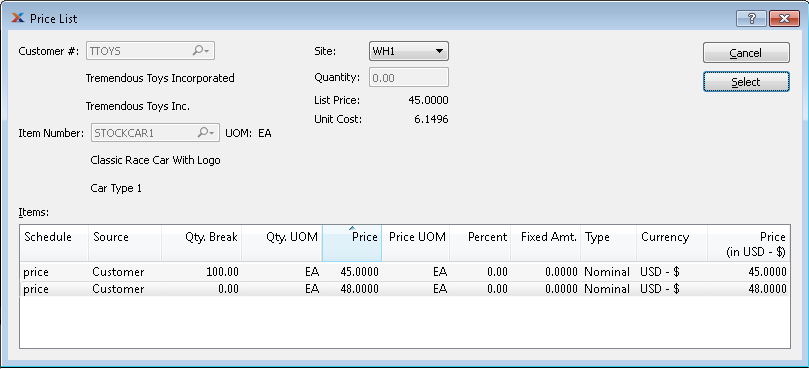
When entering the net Unit Price for a Quote Line Item, you are presented with the following options:
Displays the Customer associated with the specified Quote. The name of the Customer will also be displayed.
Displays the Item Number associated with the specified Quote Line Item.
Inventory Unit of Measure.
Displays Line Item quantity specified on previous screen.
Display lists available pricing for the specified Quote Line Item.
The following buttons are unique to this screen:
Highlight a Price from the list of Prices, then select this button to enter the Price in the "Net Unit Price" field on the previous screen.